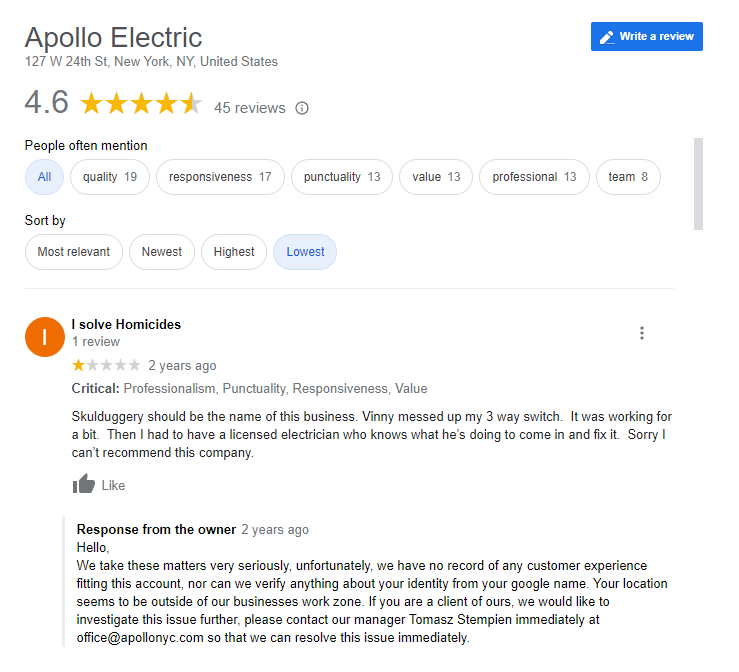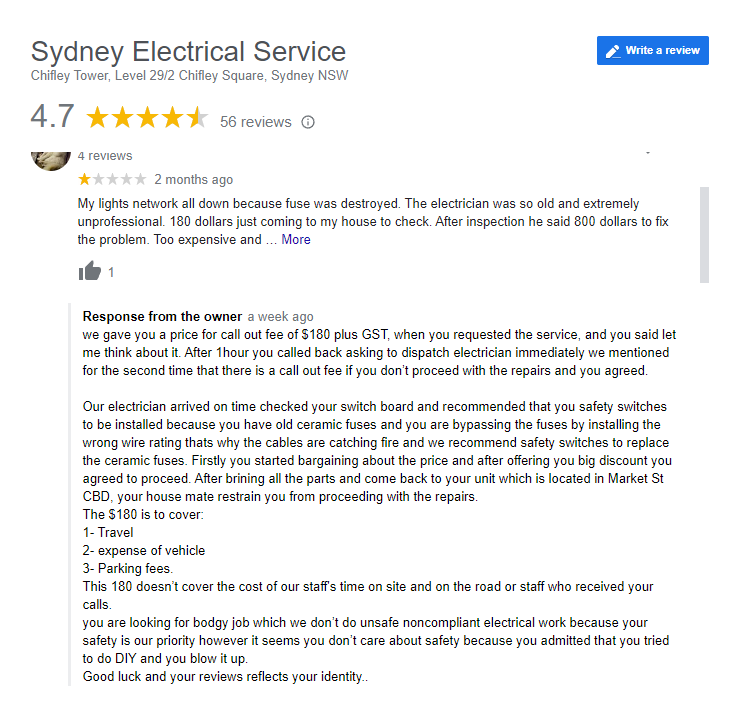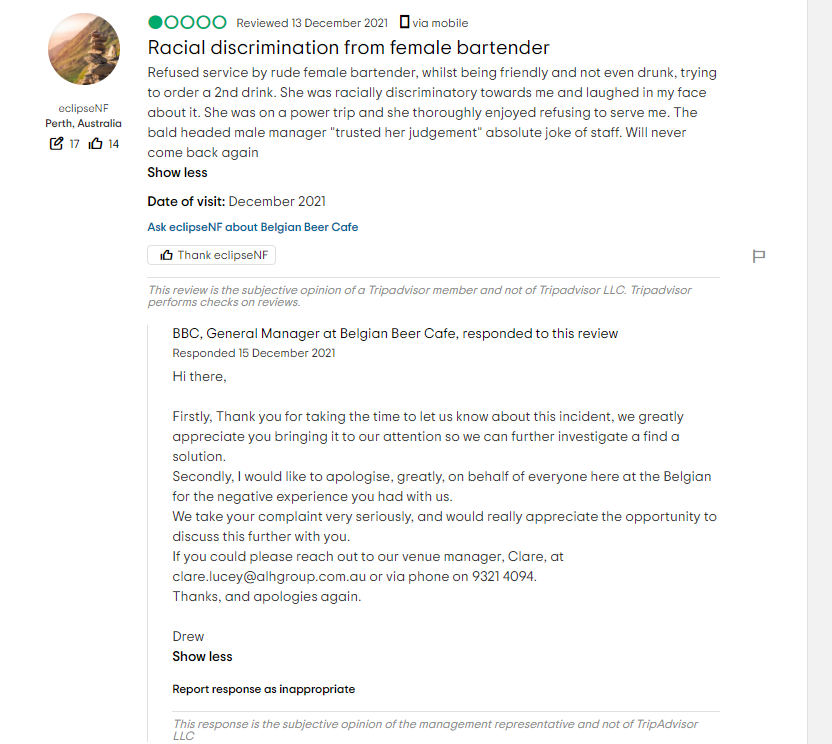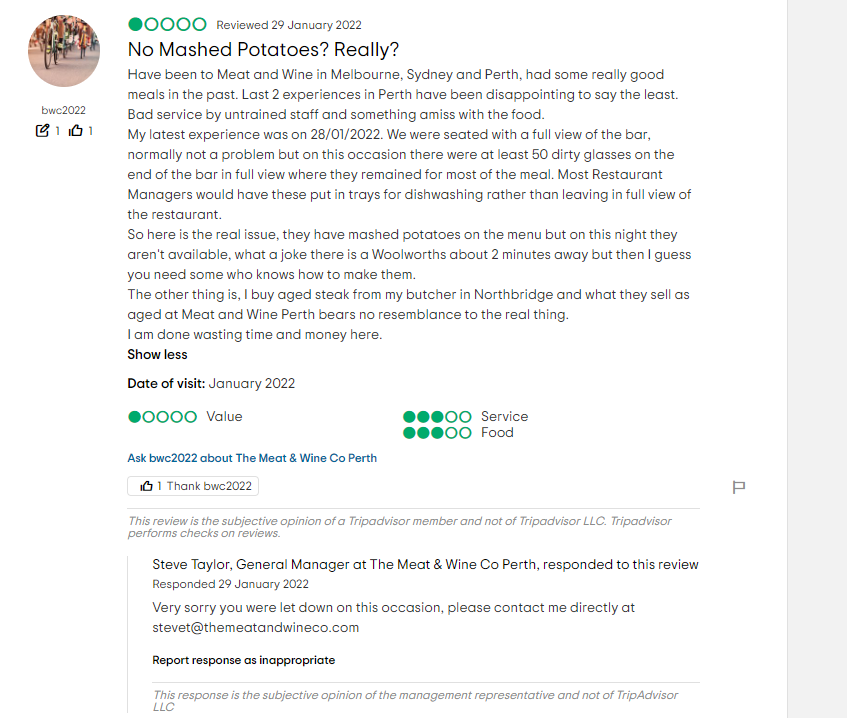
Examples of dealing with angry customers (and 8 tips to save your skin)
Need some examples of dealing with angry customers to show you how to handle even the most savage complaint? We've got you covered.
Table of Contents
You want all your customers to leave your business happy and appreciative of your product or service. But that's not always the case.
You can't please everybody.

One angry customer can ruin your day, the team's day and another customer's day. Therefore, learning how to handle angry customers can resolve the experience of not only the angry customer but everyone who witnesses it.
Knowing how to navigate customer complaints and handle angry customers can become invaluable business skills. It's also something that can boost your company's reputation. If you can turn an angry customer into one that feels heard and respected, you're potentially going to remove the issue that was there in the first place.
It's about flipping the switch on this customer's experience.
If you don't have a specific customer service team, then all your staff - including you - should know how to deal with upset customers.
Read on for our 8 tips to boost customer satisfaction and pacify difficult customers (just remember, there are a few ways to handle angry customers).
1) Active listening
Huh? Isn't listening always active? Think about this: you're on a walk and listening to a podcast but you've realised you haven't taken anything in and now you need to hit rewind. Your eyes are working, but you're not paying attention. And, customers can tell when you're not hearing what they're saying.
Those glazed-over eyes reveal that your business doesn't want to listen to a customer's feelings and you're only going to make an irate customer even angrier.
Show attentiveness to your angry customers and practice active listening. Let them address their complaints without any defence. Let their side be heard first.
Customer complaints are part of your review management, so if you're not actually listening to them, you're not doing your part.
2) Remain calm
This one seems simple, doesn't it? But if an angry client is letting you know that they've had a negative experience with your business, it might sting a little.
The key here is to always remain calm. This is a professional exchange of words and you need to remain professional. Angry customers want to be treated with respect, even if they're raising their voice.
By remaining calm, you're showing that you take your business seriously and it will also encourage angry clients to calm their tone, and de-escalate the situation. Don't fight fire with fire. Stay calm.
3) Be thankful
If a customer is sharing their customer experience with you, you should be grateful. It's an inside take on how your business is operating and you can improve an aspect of your business just from customer complaints.
Just say:
- Thank you for bringing the issue to your attention
- Thank you for sharing your customer experience with me
- Thank you for taking the time to address this
Positive language helps ease any tension.
4) Explain the steps that need to be taken to resolve the issue
Handle irate customers, it's not just about pacifying the situation, it's about letting them know that you can genuinely resolve their issue.
- Address who it is that you need to speak to (if you're not the business owner or manager that is actively listening to an angry customer)
- Let them know that you will speak to the team member (if the issue is with someone who works at the business), replace a product (if the issue is with something the customer has bought) or issue a refund (if this is the only solution)
- Let the customer know how long this will all take
- Address the complaint as a priority
Keep your customers happy but let them know that their complaints are always a priority. Once you've outlined the steps that you need to take to fully resolve the issue (step 3).
You can prove this is a priority by logging the complaint and CCing the customer (if online) or if it's an in-person complaint, give them a call later in the day to highlight the steps you have taken since the complaint.
Using time to follow up on their query or issue is also a good way to let the customer know, you're not just going to forget about them.
5) Use positive language
Positive words will affirm that you're an easy person to talk to and you'll be willing to listen to a complaint. Things like, "I'm happy to help you with this issue," "I completely understand why you'd want that" or "I understand how frustrating that must be."
With positive language, you're validating their feelings and not condemning their experience as a wrong interpretation.
6) Be authentic and sincere
Angry customers dealing with a manager want to know that their complaint isn't only heard and reacted to but genuinely appreciated.
This means you need to tell your face to appear compassionate as well as your language. If you genuinely care about your business, your expression will show that. Just check in with yourself to make sure you LOOK like you care.
People want authenticity. If they have a problem with your business, and you sincerely want to resolve the issue, you'll end up turning them into a loyal customer.
7) Don't be afraid to acknowledge aggressive language
Handling difficult customers doesn't mean that you're a punching bag. There's still a way for any human to speak to another human and that's with a calm voice and expressive language, but that doesn't mean swearing, hateful or violent language.
If you ever feel unsafe online or in the person handling an angry customer, take action such as reporting the abuse or calling a policeman if you feel vulnerable.
Make sure your company's policy around violence or aggression is stipulated in-store and online, so your customers (no matter how angry they are) will respect it.
And make sure you have a support team around you. It's a big deal to diffuse a situation and deal with angry customers (especially if you're always having to deal with angry customers). Spend time with friends, support agents and other team members so that you also have some time to relax. Negative language and difficult conversations can take their toll, so make sure you're looking after you, too.
8) Repeat the words used by your customer
This is a way to influence people that you're listening to and hearing the complaint. By repeating what your customer is saying, you're validating their experience.

For example:
- "I feel this business should refund me as the item is broken" to "You feel that a refund would be honest compensation as what you bought is broken."
Steer the customer conversation in a direction that affirms the customer's feelings.
Simple, right? But it's effective and affirms the right decision for the customer and identifies what will solve the issue.
Examples of dealing with bad reviews
Let's look at these four examples below for online reviews. Are the responses using any of the tips above?

This looks like a fake review, and an angry fake review at that. The response from the owner is calm, collected and offers a solution. It also speaks to the identify of the reviewer letting potential customers know that this isn't genuine.
All in all, a great response to an angry review (even if it is fake).

Okay, this review response seems quite defensive. The language is specific and he does repeat the words used by the reviewer, yet it also appears quite unprofessional. 'Good luck and your reviews reflect your identity' and 'You are looking for a bodgy job' - these parts appear slightly vicious.
It could have been handled a lot better.

This is a serious complaint and needs to be handled with sincerity and prioritised.
The response is clear, apologetic and it seems the team really want to put this customer's mind at ease - they're wanting to address the issue immediately.

This person really wants mashed potatoes.
They didn't get any mashed potatoes.
This made them angry.
The review response is calm but short. The General Manager is wanting the reviewer to contact him directly about his love of mashed potatoes, so it's technically an efficient review response.
Dealing with angry customers in your review management
Following on from all the above tips, you can implement these in your review management. Dealing with angry customers online with your review responses is a major part of handling your reputation. Whether in person or online, active listening and the ability to remain calm and prioritise your customer's concerns will be well regarded as a response (even if you don't always agree).
You might be wondering why you should let your customer vent if you believe you offer great customer service, well, that's what reviews are for. Even if you don't agree with your customer, it's a chance to learn something new about your business from the customer's perspective and having a customer conversation in a public forum shows prospective customers and loyal customers that you truly care about the impact of your business.
Of course, there are a few exceptions such as the use of profanities or untruths, but as long as you report those reviews and focus on your review responses to the genuine ones, you'll be impressing many customers and establishing your brand as one that cares.
The key to dealing with unhappy customers online is making sure you respond to their complaints quickly. The quicker you handle a heated situation, the more likely you are to make your customer feel respected and heard.
Wrapping up
Most companies will have to deal with an angry customer at some point so it's good to employ techniques to not only diffuse a situation but to make your customer feel heard. The trick is to not let irate customers get under your skin, especially when there's a relatively formulaic approach to follow when dealing with difficult customers.
When solving an issue, your customer wants air time to vent first. This is just human nature. You can turn a difficult customer into one that feels appreciated. It's even better if you can solve their issue quickly.
When it comes to hearing your customer, implementing software such as Cloutly - a review management tool - you can save a lot of complaints. Cloutly will notify you with every new review you receive across most review sites. This means you have time to check out the review, think about it, and then respond accordingly using any of the techniques above.
Being onto your reviews lets your customers know that you want to care about your business and what they think of you.
You can even send out humanised review requests using video or text to garner more 5-star reviews than ever.



